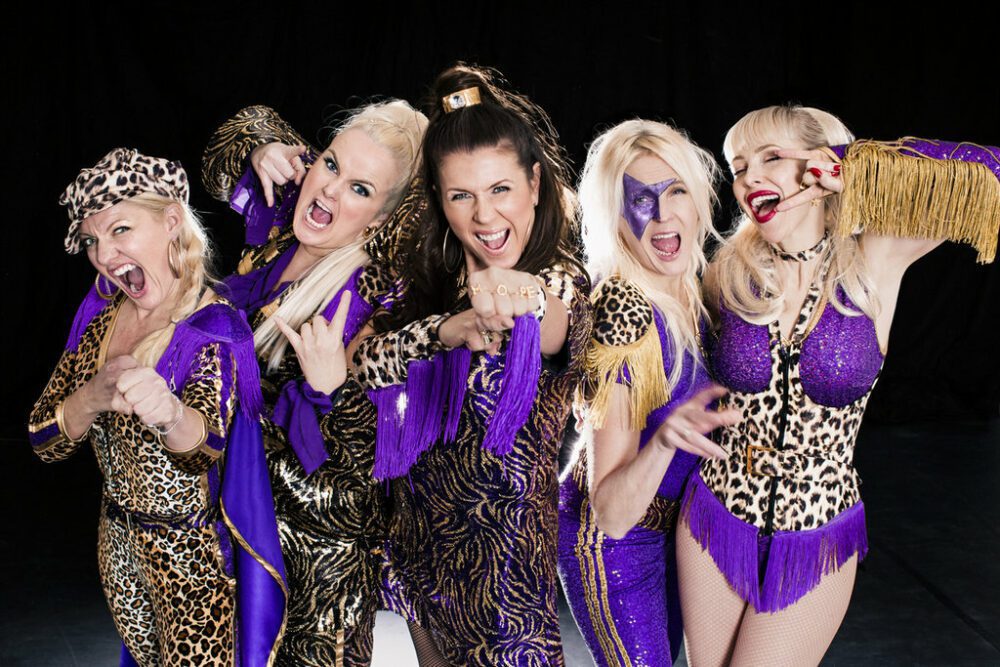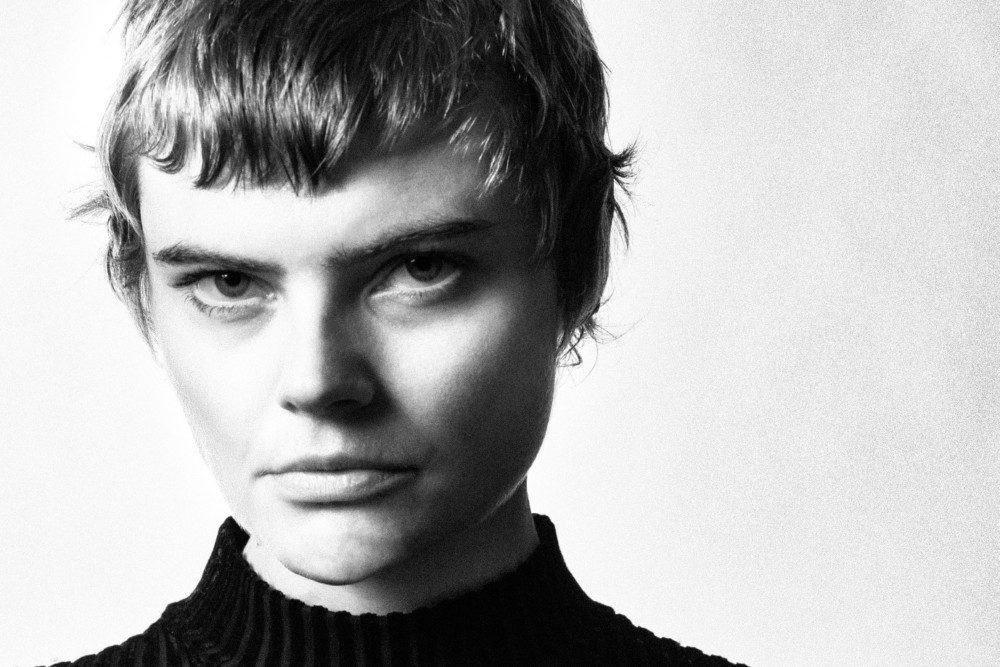

On a recent Zoom call, Silje Hope and Sugar Cane are in agreement that “Say My Name” is Cocktail Slippers’ favorite song to perform live. “It’s a lot of fun to play,” says lead singer Hope on a Zoom call from her home in Oslo. It’s a dark song, she adds, the lyrics focusing on the proverbial devil-on-your-shoulder tempting you.
“This song is quite tough,” says bassist Cane, whose joins us from Bergen, where she’s visiting family. The band wanted portray that toughness in their raucous new video, premiering today on Audiofemme. Cocktail Slippers filmed the clip themselves inside their rehearsal room, the band members dressed in purple sequins and leopard print. Their shadows dance along the wall behind them, where you can occasionally catch a glimpse of the horror classic Nosferatu. Cane adds, “We’re quite proud that we’re a productive band that makes everything ourselves.”
Last month, the Norwegian five-piece released Shout It Out Loud!, their fifth album (and their first in seven years), on NYC-based label Wicked Cool Records. “We wanted to make this album for a really long time,” says Cane. Recording stalled due to changes in the band, though they continued playing shows. Then, the release was delayed as a result of the COVID-19 pandemic.
“It’s not that easy to make an album,” says Cane. The band wasn’t keen on the idea of releasing it when music scenes across the world had come to a halt. “We wanted to promote it, do gigs, not just release it,” she explains.
Instead, they chose to release singles until venues where they could fully unleash the full-length began to reopen. That turned out to be a good move. Cocktail Slippers have been able to play live a few times since this past summer, including a record release gig. It was a little different from their usual shows, though – the audience had to be seated and the tables were socially distanced from each other. “We’ve been living under very hard restrictions here in Oslo,” says Hope, noting that the rules have loosened up in Norway since then.
“It takes time to get used to going to concerts again and everything, but we did have a fantastic release for the album,” she adds. “Even though people had to sit down for most of it, we were able to walk around.”
“It’s going to be great when people can stand and not have to worry about touching other people. It’s going to be very different. I’m looking forward to that,” says Cane. She adds that she was glad that the energetic rock band didn’t have to perform sitting down. “That would be awful,” she says.
“I can’t even imagine that – us sitting on stairs,” says Hope. “We’re not that kind of band.”
It’s true – sitting demurely is not Cocktail Slippers’ style at all. For 20 years they’ve been honing a garage rock sound that’s a little retro and a little modern. One of the standout tracks on Shout It Out Loud! is their cover of “Hush,” styled after Deep Purple’s 1968 rendition. They originally performed the cover as part of a television special in Norway.
“We had so much fun doing it. This song is great,” says Hope. The band went on to incorporate it into their live sets and it did really well with fans. “Everyone knows the na-na part. Everyone knows the song,” says Hope. “People were asking us about it, so that was why we played it a lot.”
Still, they hadn’t recorded it, not until they intended to release it as a B-side for a 7” release of “She Devil (Shout It Out Loud).” They recorded it as if they were playing it live inside the same studio where they made the rest of the album. When they sent the finished product to Steven Van Zandt, who founded Wicked Cool Records and co-produced Shout It Out Loud! with the band, he told them that it needed to be an album track.
Cocktail Slippers have collaborated with Van Zandt a lot over the years; Springsteen fans know him well as regular guitarist and mandolin player in Bruce’s E Street Band. “We’re not sure how he found our record,” says Sugar Cane, but it was sometime in the early ‘00s. “He picked it up on his radio station and we didn’t know that he was playing it for a year when he contacted us and wanted us to play on a festival in New York City. That was the first contact we had with him.”
In their two decades as a band, there have been challenges for Cocktail Slippers. It’s difficult when members move from Oslo; the logistics of touring gets complicated when band members have kids. “The success is that we’re having so much fun together,” says Hope. “I think that a special energy is created when we play.”
The pandemic made things especially tricky though, depriving the band of their income from performing. “How can we rehearse, release the album, get PR and do photo shoots and video shoots with no income? That’s a challenging thing,” says Hope. “But the success is that we are really, really proud of this record.” Now back and better than ever, Cocktail Slippers channeled plenty of pent-up energy into the video for “Say My Name” – and allow fans across the world to appreciate the explosive energy that’s gotten the band through it all.
Follow Cocktail Slippers on Facebook and Instagram for ongoing updates.


